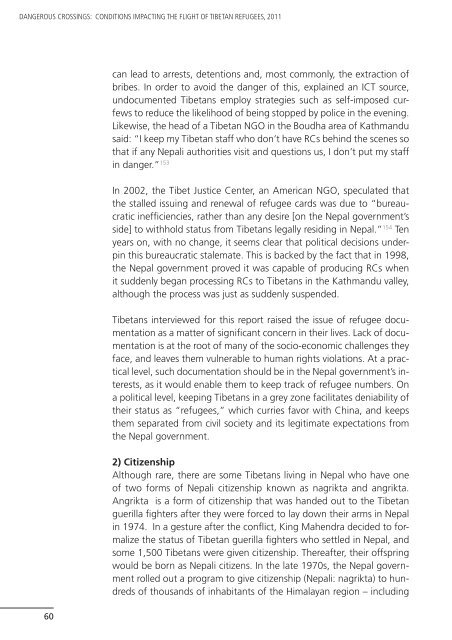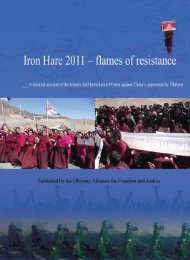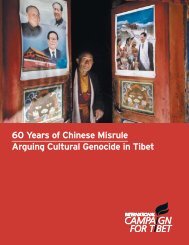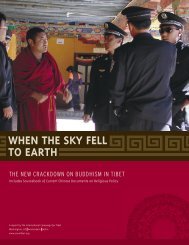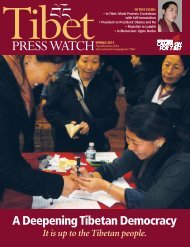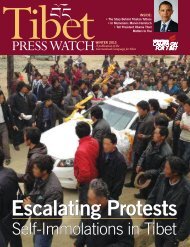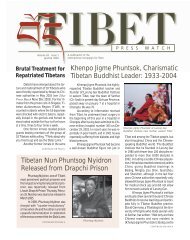DANGEROUS CROSSING: - International Campaign for Tibet
DANGEROUS CROSSING: - International Campaign for Tibet
DANGEROUS CROSSING: - International Campaign for Tibet
You also want an ePaper? Increase the reach of your titles
YUMPU automatically turns print PDFs into web optimized ePapers that Google loves.
<strong>DANGEROUS</strong> <strong>CROSSING</strong>S: CONDITIONS IMPACTING THE FLIGHT OF TIBETAN REFUGEES, 2011<br />
60<br />
can lead to arrests, detentions and, most commonly, the extraction of<br />
bribes. In order to avoid the danger of this, explained an ICT source,<br />
undocumented <strong>Tibet</strong>ans employ strategies such as self-imposed curfews<br />
to reduce the likelihood of being stopped by police in the evening.<br />
Likewise, the head of a <strong>Tibet</strong>an NGO in the Boudha area of Kathmandu<br />
said: “I keep my <strong>Tibet</strong>an staff who don’t have RCs behind the scenes so<br />
that if any Nepali authorities visit and questions us, I don’t put my staff<br />
in danger.” 153<br />
In 2002, the <strong>Tibet</strong> Justice Center, an American NGO, speculated that<br />
the stalled issuing and renewal of refugee cards was due to “bureaucratic<br />
inefficiencies, rather than any desire [on the Nepal government’s<br />
side] to withhold status from <strong>Tibet</strong>ans legally residing in Nepal.” 154 Ten<br />
years on, with no change, it seems clear that political decisions underpin<br />
this bureaucratic stalemate. This is backed by the fact that in 1998,<br />
the Nepal government proved it was capable of producing RCs when<br />
it suddenly began processing RCs to <strong>Tibet</strong>ans in the Kathmandu valley,<br />
although the process was just as suddenly suspended.<br />
<strong>Tibet</strong>ans interviewed <strong>for</strong> this report raised the issue of refugee documentation<br />
as a matter of significant concern in their lives. Lack of documentation<br />
is at the root of many of the socio-economic challenges they<br />
face, and leaves them vulnerable to human rights violations. At a practical<br />
level, such documentation should be in the Nepal government’s interests,<br />
as it would enable them to keep track of refugee numbers. On<br />
a political level, keeping <strong>Tibet</strong>ans in a grey zone facilitates deniability of<br />
their status as “refugees,” which curries favor with China, and keeps<br />
them separated from civil society and its legitimate expectations from<br />
the Nepal government.<br />
2) Citizenship<br />
Although rare, there are some <strong>Tibet</strong>ans living in Nepal who have one<br />
of two <strong>for</strong>ms of Nepali citizenship known as nagrikta and angrikta.<br />
Angrikta is a <strong>for</strong>m of citizenship that was handed out to the <strong>Tibet</strong>an<br />
guerilla fighters after they were <strong>for</strong>ced to lay down their arms in Nepal<br />
in 1974. In a gesture after the conflict, King Mahendra decided to <strong>for</strong>malize<br />
the status of <strong>Tibet</strong>an guerilla fighters who settled in Nepal, and<br />
some 1,500 <strong>Tibet</strong>ans were given citizenship. Thereafter, their offspring<br />
would be born as Nepali citizens. In the late 1970s, the Nepal government<br />
rolled out a program to give citizenship (Nepali: nagrikta) to hundreds<br />
of thousands of inhabitants of the Himalayan region – including


